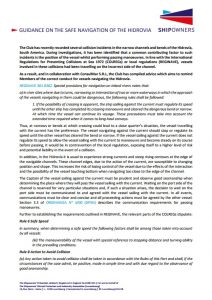The Shipowners Club informed that it has recently recorded several collision incidents in the narrow channels and bends of the Hidrovía, South America, due to wrong position of the vessels whilst performing passing manoeuvres. As a result, and in collaboration with ConsulMar S.R.L, the Club has compiled advice on the correct conduct for vessels navigating the Hidrovía.
In line with the International Regulations for Preventing Collisions at Sea 1972 (COLREGs) or local regulations (REGINAVE), vessels involved in these collisions had been travelling on the incorrect side of the channel, the Club explained.
Firstly, according to REGINAVE 301.0302, at narrows or bends at which crossing could lead to a close quarter’s situation, the vessel travelling with the current has the preference. The vessel navigating against the current should stop or regulate its speed until the other vessel has cleared the bend or narrow.
As explained, “if the vessel sailing against the current does not regulate its speed to allow the vessel sailing with the current to manoeuvre and become steady on its course before passing, it would be in contravention of the local regulation, exposing itself to a higher level of risk.”
In addition, in the Hidrovía it is usual to experience strong currents and steep rising contours at the edge of the navigable channels. Due to the action of the current, these channel edges are susceptible to changing position and shape, that increases the risk of losing control of the vessel due to the effects of the interaction and the possibility of the vessel touching bottom when navigating too close to the edge of the channel.
“Waiting on the port side of the channel is reserved for very particular situations and, if such a situation arises, the decision to wait on the port side must be communicated to and agreed with the vessel sailing with the current. In all events, communications must be clear and concise and all proceeding actions must be agreed by the other vessel,” the Club points out.
Further details may be found by reading the official document:






























































